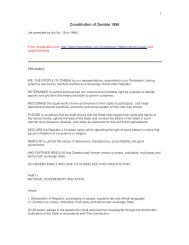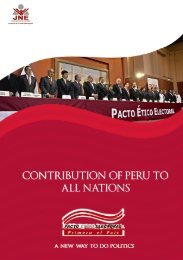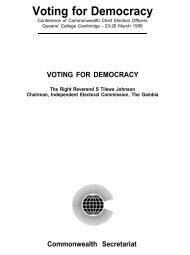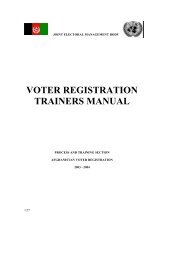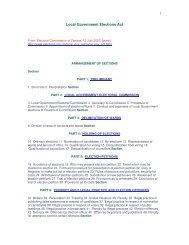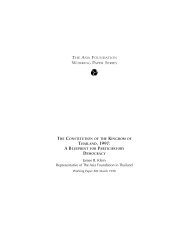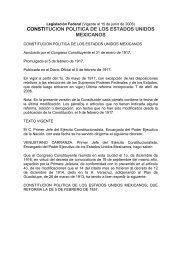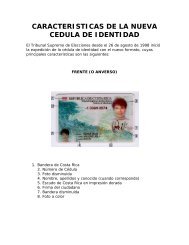Resolution of Disputes related to Electoral Results
Resolution of Disputes related to Electoral Results
Resolution of Disputes related to Electoral Results
You also want an ePaper? Increase the reach of your titles
YUMPU automatically turns print PDFs into web optimized ePapers that Google loves.
IFES RULE OF LAW CONFERENCE PAPER SERIESThe <strong>Resolution</strong> <strong>of</strong> <strong>Disputes</strong>Related <strong>to</strong> “Election <strong>Results</strong>”:A SNAPSHOT OF COURT PRACTICE IN SELECTEDCOUNTRIES AROUND THE WORLDPrepared for the Indonesian Constitutional Court Workshop on“The Role <strong>of</strong> the Constitutional Court in Resolving Election Result <strong>Disputes</strong>Through a Transparent Adjudication Process”, Indonesia, February 2004February 2004VIOLAINE AUTHEMANContribu<strong>to</strong>rsADRIAN KOCERHAKEITH HENDERSON
Violaine AuthemanTHE RESOLUTION OF DISPUTES RELATED TO “ELECTION RESULTS”:A SNAPSHOT OF COURT PRACTICE IN SELECTED COUNTRIES AROUND THE WORLD1. Introduction and Scope <strong>of</strong> the PaperOne <strong>of</strong> the main characteristics <strong>of</strong> a functioning democracy is the peaceful, periodic transition in <strong>of</strong>fice throughfree and fair elections, which are perceived as legitimate by the public. The consolidation <strong>of</strong> democracy requiresa functioning election process, which, in turn, depends upon an adequate institutional Rule <strong>of</strong> Law framework,transparent regulations, court rules and procedures and, perhaps more importantly, fully trained, competentjudges and personnel with integrity. A proper election requires full attention <strong>to</strong> be given <strong>to</strong> the five core aspects<strong>of</strong> the process: (i) prepara<strong>to</strong>ry activities; (ii) campaigning and information dissemination; (iii) voting; (iv)counting and (v) dispute resolution.Dispute resolution is the climax <strong>of</strong> the election process. The legitimacy <strong>of</strong> the election process depends in part onthe objectivity and impartiality <strong>of</strong> dispute resolution mechanisms. This objectivity and impartiality is key <strong>to</strong> buildingpublic confidence in democratic institutions and in the election process. It is only when citizens view the electionprocess as legitimate and sound that they will participate in it. One <strong>of</strong> the on-going challenges for emerging andestablished democracies, such as Indonesia, Mexico and United States, is <strong>to</strong> master the election process and ensurethat any dispute challenging “election results” is resolved in a timely, fair and effective manner.The purpose <strong>of</strong> this paper is <strong>to</strong> provide the new Indonesian Constitutional Court with guidance for theresolution <strong>of</strong> disputes <strong>related</strong> <strong>to</strong> election results, by providing baseline information <strong>to</strong> fuel the debates in aworkshop organized by IFES for the Indonesian Constitutional Court judges and staff on issues <strong>of</strong> election resultdisputes and court administration. We were specifically tasked with a survey <strong>of</strong> existing case law on how courtsin Asia and globally have resolved disputes <strong>related</strong> <strong>to</strong> “election results.”For purposes <strong>of</strong> this analysis, we have defined the term “election results” quite narrowly, placing primaryemphasis on cases that relate <strong>to</strong> technical vote counting issues rather than those involving broader fraud oraccess issues. However, we should note at the outset that the notion <strong>of</strong> “election result” has an extremely flexibledefinition and that we have observed significant variations around the world. Moreover, litigation <strong>related</strong> <strong>to</strong>“election results” is <strong>of</strong>ten closely <strong>related</strong> <strong>to</strong> other election issues that seemingly do not relate <strong>to</strong> the numericalresults <strong>of</strong> elections yet are intrinsically linked <strong>to</strong> them, such as irregularities in the registration process, fraud,or the lack <strong>of</strong> access during the voting and counting phases.This paper is intended <strong>to</strong> provide a snapshot <strong>of</strong> the various ways high-level courts have resolved disputes <strong>related</strong><strong>to</strong> “election results” in different regions <strong>of</strong> the world. A cursory survey <strong>of</strong> the existing research and case lawdid not provide us with significant guidance as <strong>to</strong> the specific means or procedures utilized by the courts <strong>to</strong>resolve disputes <strong>related</strong> <strong>to</strong> technical vote-counting claims. Two likely reasons for this are (i) that most <strong>of</strong> thesekinds <strong>of</strong> claims are resolved at either the election tribunal or lower court level, and (ii) that most cases, whetherfrom lower or higher courts, are not published or accessible. Our research survey, however, did provide someguidance as <strong>to</strong> the kinds <strong>of</strong> “election result” cases that have been decided by Constitutional Courts and SupremeCourts in selected countries around the world.In general, it should be noted that there is a paucity <strong>of</strong> readily accessible judicial and scholarly research ontechnical issues <strong>related</strong> <strong>to</strong> “election results”, especially if research covering allegations <strong>of</strong> elec<strong>to</strong>ral fraud oraccess claims is excluded. However, considerably more research is available on other kinds <strong>of</strong> disputes affectingthe democratic process and elections, as well as on those <strong>related</strong> <strong>to</strong> political parties. The research undertaken* Edited by Keith Henderson, IFES Senior Rule <strong>of</strong> Law Advisor. This paper was made possible thanks <strong>to</strong> the invaluable research andwriting contributions <strong>of</strong> Adrian Kocerha. The author also wishes <strong>to</strong> thank Jeff Fischer and Tom Bayer at IFES for their commentarieson earlier versions <strong>of</strong> this paper.1
IFES Rule <strong>of</strong> Law Conference SeriesIndonesian Constitutional Court WorkshopBogor, February 26-28, 2004for this assignment clearly needs <strong>to</strong> be supplemented in order <strong>to</strong> have a full picture <strong>of</strong> exactly what kinds <strong>of</strong>issues have arisen and how they were resolved at both the lower court and election tribunal levels. Much <strong>of</strong> thiswould necessarily require interviews and in-country research at the local level.Our research was primarily focused on identifying decisions rendered by Constitutional Courts and SupremeCourts in response <strong>to</strong> challenges <strong>of</strong> election results in the past five <strong>to</strong> ten years. The identification processproved difficult, but we were able <strong>to</strong> gather significant secondary reports <strong>of</strong> such cases. Media and newsreports were an invaluable source <strong>of</strong> information that enabled us <strong>to</strong> identify potentially relevant court cases.One important obstacle <strong>to</strong> comprehensive case law research is that even when the highest courts publish theirdecisions on disputes <strong>related</strong> <strong>to</strong> election results, these decisions are <strong>of</strong>ten available only in the local languageand/or by request in hard copy.Another component <strong>of</strong> our research methodology was the identification <strong>of</strong> academic and applied researcharticles on the <strong>to</strong>pic <strong>of</strong> election dispute resolution. A cursory review <strong>of</strong> available literature did not yield theresults we had anticipated. We then interviewed election law experts at IFES and contacted many electiondispute resolution specialists around the world. While these interviews and exchanges <strong>of</strong> information did notalways provide us with pertinent materials, they did provide significant guidance as <strong>to</strong> what kind <strong>of</strong> informationon this specific <strong>to</strong>pic might be available and where. Most <strong>of</strong> these experts and specialists broadly interpreted theterm “election result” disputes, and this interpretation was likewise affirmed through our case law research.During the course <strong>of</strong> our current research and interviews with election law experts, a number <strong>of</strong> importantquestions and issues have arisen that need <strong>to</strong> be more closely examined and debated, such as the impact <strong>of</strong>irregularities in the registration process, widespread fraud, and lack <strong>of</strong> access on election results; how <strong>to</strong>properly identify invalid ballots; and whether the proper court rules, procedures and regulations are in place <strong>to</strong>resolve disputes within a specified, transparent timeframe.For the reasons noted above, this paper will focus primarily on a narrow interpretation <strong>of</strong> the notion <strong>of</strong> “electionresult” dispute (section 3), as derived from the guidance we have received relative <strong>to</strong> the laws that concern theconcurrent jurisdiction <strong>of</strong> the Indonesian Constitutional Court and the Supreme Court (section 2) over electiondisputes. Having outlined the general boundaries <strong>of</strong> rapid response mechanisms for election dispute resolution(section 4), the paper will then attempt <strong>to</strong> provide an analytical overview <strong>of</strong> selected case law from countriesaround the world, with a focus on developing and transition countries (section 5).2. Jurisdiction <strong>of</strong> the Indonesian Constitutional CourtBased on a summary review and analysis <strong>of</strong> the laws regulating legislative general elections and presidentialgeneral elections in Indonesia, it appears that several dispute resolution entities have concurrent and potentiallyoverlapping jurisdiction when it comes <strong>to</strong> disputes arising from the election process. 1There are three bodies entrusted with responsibilities in the settlement <strong>of</strong> disputes arising from the election process:(i)(ii)(iii)The Election Supervisory Committees;The courts <strong>of</strong> general jurisdiction, i.e., District Courts and Supreme Court; andThe Constitutional Court.1 Information and analyses in this section are primarily drawn from Indonesian Law no. 23 <strong>of</strong> 2003 on the General Election <strong>of</strong> thePresident and Vice President (July 2003) articles 68 and 77 through 85, and Indonesian Law no. 12 <strong>of</strong> 2003 on General Elections forthe Members <strong>of</strong> the People’s Representative Council, the Regional Representative Council, and the Regional People’s RepresentativeCouncil (March 2003) articles 104 and 127 through 134. Both laws are available in English on the IFES website athttp://www.ifes.org/reg_activities/indonesia_political_laws.html2
Violaine AuthemanIn both legislative general elections and presidential elections, the Election Supervisory Committees have theprimary responsibility for resolving disputes <strong>related</strong> <strong>to</strong> the conduct <strong>of</strong> the election, provided the allegations donot pertain <strong>to</strong> violations <strong>of</strong> a criminal nature. The complaint must be brought before the terri<strong>to</strong>rially competentCommittee within seven days <strong>of</strong> the violation. Once the decision <strong>to</strong> process is made and if an attempt atconciliation fails, the Committee renders a final and binding decision within fourteen days.Similarly, under both laws, the courts <strong>of</strong> general jurisdiction are responsible for the adjudication <strong>of</strong> elec<strong>to</strong>ralcriminal violations occurring during the election process. For <strong>of</strong>fenses punishable by no more than an 18-monthimprisonment, the District Courts have final jurisdiction. For all other <strong>of</strong>fenses, an appeal <strong>to</strong> the relevant HighCourt is possible and shall be final and binding. Therefore, appeals <strong>to</strong> the Supreme Court are not possible forcriminal sentences <strong>of</strong> less than 18 months, as a way <strong>to</strong> prevent an elec<strong>to</strong>ral criminal <strong>of</strong>fense case from takingmonths or even years before a decision is rendered. District Courts have 21 days <strong>to</strong> render their decisions, whilethe High Courts have 14 days.Finally, while the Constitutional Court has exclusive jurisdiction over disputes <strong>related</strong> <strong>to</strong> “election results”, andthe law on presidential general elections explicitly defines the scope <strong>of</strong> the Constitutional Court’s jurisdiction,limiting it <strong>to</strong> objections against “vote count results”, it should be noted that the law on legislative generalelections is silent on the meaning <strong>of</strong> “election results”. Similarly, the law on presidential general elections gives14 days <strong>to</strong> the Constitutional Court <strong>to</strong> resolve disputes, but the law on legislative general elections does notprovide any specific timeframe.As described above, the Constitutional Court’s jurisdiction is not as restrictively defined in the context <strong>of</strong>parliamentary, provincial and municipal elections as it is in the context <strong>of</strong> presidential general elections. Whilethis situation arguably may give the Constitutional Court some flexibility in interpreting the notion <strong>of</strong> “electionresults”, some caution is necessary in order <strong>to</strong> avoid potential conflicts in the case law arising from electiondisputes. It also opens the door <strong>to</strong> undue delays or public confusion.Indeed, discrepancies between the two laws may lead <strong>to</strong> potential overlapping or even conflicting decisionsfrom several dispute resolution bodies. In any case, the lack <strong>of</strong> definition <strong>of</strong> the notion <strong>of</strong> “election results” inthe legislative general election law may pose serious jurisdictional issues for the Court in the future. At the sametime, it also may mean that the Constitutional Court, as a guaran<strong>to</strong>r <strong>of</strong> fundamental democratic principles andcivil liberties under the Indonesian Constitution, may want <strong>to</strong> be prepared <strong>to</strong> confront this jurisdictional andtiming issue for purposes <strong>of</strong> future decision-making. This could be done through an amendment <strong>to</strong> the currentlaw, a regulation or perhaps through a future court decision.3. Notion <strong>of</strong> “Election Result” <strong>Disputes</strong> and their <strong>Resolution</strong>a. Narrow and Broad InterpretationsBased on our preliminary research and on discussions with jurists and election specialists from a variety <strong>of</strong>countries, the notion <strong>of</strong> “election result” disputes appears <strong>to</strong> cover a wide array <strong>of</strong> cases and complaints, butbroad and narrow interpretations <strong>of</strong> the scope <strong>of</strong> these disputes vary greatly depending on the country, thecourt or even over time. While “election result” disputes could be broadly unders<strong>to</strong>od <strong>to</strong> cover all claimsbrought <strong>to</strong> court following an election provided that these claims call in<strong>to</strong> question the validity <strong>of</strong> the outcome<strong>of</strong> the election, the starting point for this paper is a narrower interpretation <strong>of</strong> the notion. Based upon informalguidance from Indonesian jurists, we have interpreted “election result” disputes <strong>to</strong> cover challenges <strong>related</strong> <strong>to</strong>the count <strong>of</strong> ballots following the vote. However, we would encourage a more scholarly analysis <strong>of</strong> this issue bya wider range <strong>of</strong> Indonesian jurists before any definitive interpretation <strong>of</strong> this term is made.3
IFES Rule <strong>of</strong> Law Conference SeriesIndonesian Constitutional Court WorkshopBogor, February 26-28, 2004As a general matter, it is possible <strong>to</strong> highlight two diverging approaches <strong>to</strong> the notion <strong>of</strong> “election result”. Thefirst is a process-oriented approach and the second an outcome-oriented approach. Process-oriented approaches<strong>of</strong> “election result” disputes do not dissociate ballot counting from broader fraud and access issues. Outcomeorientedapproaches build looser ties between disputes over ballot counting and more general challenges <strong>to</strong> theelection process based on fraud or access.This distinction does not mean, however, that ballot counting is a stand-alone issue. Rather, there might be threecategories <strong>of</strong> claims <strong>related</strong> <strong>to</strong> ballot counting:(i) Claims exclusively targeting the mathematical count <strong>of</strong> ballots;(ii) Claims which inherently raise issues <strong>of</strong> fraud in the counting process; and(iii) Claims which inherently raise access issues.The 1996 Armenian presidential election provides a good example <strong>of</strong> the linkages between counting, fraudand access. Indeed, complaints calling for the nullification <strong>of</strong> the election relied on inconsistencies in the finalnumerical results provided by precincts, noting that the universal, equal, direct suffrage and secret voting hadbeen violated during the vote, and that there were fraudulent inconsistencies in the counting <strong>of</strong> ballots, both <strong>of</strong>which had had a direct effect on the election results.There is, however, an important caveat <strong>to</strong> this narrow interpretation <strong>of</strong> the scope <strong>of</strong> “election result” disputes.Indeed, it appears from our research that claims <strong>related</strong> <strong>to</strong> vote counting <strong>of</strong>ten constitute only one aspect <strong>of</strong>broader fraud or access claims. Indeed, most <strong>of</strong> the cases surveyed covered a wide range <strong>of</strong> <strong>of</strong>ten overlappingissues, and, while the core claim was not vote counting as such, the sought outcome <strong>of</strong> the challenge was alwaysa modification or an annulment <strong>of</strong> the final count.b. Elements <strong>of</strong> “Election Result” <strong>Disputes</strong>Based on our cursory survey <strong>of</strong> existing literature and case law from Constitutional Courts and SupremeCourts, the notion <strong>of</strong> “election result” disputes appears <strong>to</strong> cover a wide range <strong>of</strong> issues which are <strong>of</strong>teninextricably linked in the challenges brought <strong>to</strong> court and fall under two broad categories: fraud and access. Thespecific issue <strong>of</strong> ballot counting falls under fraud or access challenges depending on the case. The following tablemay provide some guidance concerning the types <strong>of</strong> claims identified under each category.Challenges <strong>of</strong> Election <strong>Results</strong>Challenges Related <strong>to</strong> FraudFraud affecting the report <strong>of</strong> election resultsFraud directly linked <strong>to</strong> votingBriberyChallenges Related <strong>to</strong> AccessObstacles <strong>related</strong> <strong>to</strong> polling stationsObstacles <strong>related</strong> <strong>to</strong> voting materialsParty representation during vote and countAnnouncement <strong>of</strong> the resultsc. Systems <strong>of</strong> Dispute <strong>Resolution</strong>A cursory review <strong>of</strong> the literature analyzing jurisdictional mechanisms <strong>to</strong> resolve disputes in connection withelec<strong>to</strong>ral processes enables us <strong>to</strong> identify four main systems <strong>of</strong> dispute resolution, depending on which court hasthe primary responsibility <strong>to</strong> adjudicate cases challenging election results. First, some countries have entrustedthe resolution <strong>of</strong> elec<strong>to</strong>ral conflicts <strong>to</strong> Constitutional Courts or bodies <strong>of</strong> constitutional justice. Second, inother countries, the judiciary is responsible for the resolution <strong>of</strong> these conflicts with the possibility <strong>of</strong> appealall the way <strong>to</strong> the Supreme Court. Third, some countries have chosen <strong>to</strong> create special elec<strong>to</strong>ral tribunals <strong>to</strong>4
Violaine Authemanadjudicate cases arising <strong>of</strong> elections, as an element <strong>of</strong> their democratic transition. Fourth, some countries havemixed systems <strong>of</strong> dispute resolution. Mixed systems are characterized by a significant role given <strong>to</strong> the politicalbranches <strong>of</strong> government, such as Parliament, in the resolution <strong>of</strong> disputes, but the responsibility is shared witheither the ordinary courts or administrative entities.Dispute <strong>Resolution</strong> SystemConstitutional CourtSupreme CourtElec<strong>to</strong>ral TribunalMixed SystemCountriesMost European countries, CambodiaEngland, Canada, South Korea, India, the PhilippinesMost Latin American countriesUnited States; some countries in Latin America and Europe such as Argentina, Italyand HungaryRegardless <strong>of</strong> the specificities <strong>of</strong> the institutional system established <strong>to</strong> resolve disputes <strong>related</strong> <strong>to</strong> electionresults, there is a global consensus that these systems are fundamental <strong>to</strong> the legitimacy and integrity <strong>of</strong> theelection process. The key <strong>to</strong> legitimacy and integrity is <strong>to</strong> ensure the independence and impartiality <strong>of</strong> disputeresolution bodies. This is the approach that was taken by the international community when setting up ad hocdispute resolution bodies in post-conflict countries such as Bosnia-Herzegovina or East Timor.The independence and impartiality <strong>of</strong> dispute resolution bodies can be guaranteed best by providing them withsufficient administrative and budgetary resources and by ensuring that they are staffed with competent andimpartial judges. The transparency <strong>of</strong> dispute resolution procedures will also help strengthen the independence<strong>of</strong> and public trust in these bodies, and it will promote a Rule <strong>of</strong> Law culture. Building public trust in disputeresolution bodies and in transparent adjudication procedures is a fundamental first step in consolidatingdemocracy and the legitimacy <strong>of</strong> the election process.Our research focused primarily on decisions rendered by Constitutional Courts or Supreme Courts around theworld. Based on the cases surveyed, it is clear that many <strong>of</strong> the purely technical cases <strong>related</strong> <strong>to</strong> vote countingmost likely never reach the highest levels <strong>of</strong> the judiciary; rather, these cases are dealt with directly at thelocal or regional level by election commissions or district courts. It is also clear that in a number <strong>of</strong> countries,the Constitutional Court or Supreme Court does not have original jurisdiction over election result disputes.Indeed, in Cambodia, cases are heard by the Constitutional Court only upon appeal against decisions renderedby the National Election Commission. Similarly, in the United States, the US Supreme Court hears cases onlyupon appeal against decisions from the highest State jurisdictions.In yet other countries, several courts or bodies may have concurrent jurisdiction over disputes arising from theelection process. Indeed, in Indonesia, the Supervisory Committee, the Supreme Court and the ConstitutionalCourt all have jurisdiction over some aspects <strong>of</strong> disputes arising from the election process. These kinds <strong>of</strong>jurisdictional issues make it all the more important for all courts and resolution bodies <strong>to</strong> promote uniformcase law and the speedy resolution <strong>of</strong> cases through clear and adequate laws, procedures, rules and regulations,in order <strong>to</strong> prevent or minimize conflicts between the courts. In the absence <strong>of</strong> such guidelines, conflictinginterpretations and solutions may be given by different courts on similar factual situations, and litigants willhave an incentive <strong>to</strong> go court shopping for the most favorable decision, thereby undermining the legitimacy<strong>of</strong> the dispute resolution mechanism and <strong>of</strong> the election itself. These conflicts may also be used <strong>to</strong> delay finaldecisions and <strong>to</strong> cast doubt in the public’s eye as <strong>to</strong> which decision should prevail. Overall, these kinds <strong>of</strong>jurisdictional disputes may call in<strong>to</strong> question the legitimacy or importance <strong>of</strong> new democratic institutions suchas the Constitutional Court in Indonesia.The best source <strong>of</strong> information on the resolution <strong>of</strong> disputes <strong>related</strong> <strong>to</strong> ballot counts might, therefore, be atthe election commission or first instance tribunal level. More information on the purely mathematical and5
IFES Rule <strong>of</strong> Law Conference SeriesIndonesian Constitutional Court WorkshopBogor, February 26-28, 2004technical issue <strong>of</strong> the accurate ballot count could be obtained by undertaking research at the level <strong>of</strong> thesebodies. Similarly, working with election <strong>of</strong>ficials around the world might provide guidance with regard <strong>to</strong> themeans <strong>of</strong> resolution <strong>of</strong> technical ballot counting disputes.4. Rapid Response <strong>to</strong> “Election Result” <strong>Disputes</strong>a. Speedy, Fair and Legitimate Dispute <strong>Resolution</strong> ProcessThere is now a universal consensus that litigants are entitled <strong>to</strong> a swift resolution <strong>of</strong> their disputes byan independent and impartial tribunal. The reasonable time for dispute resolution in civil, commercial,administrative and criminal cases is a hotly debated issue which depends, inter alia, on the circumstances <strong>of</strong>the case, its complexity, the conduct <strong>of</strong> the parties and the conduct <strong>of</strong> the authorities. The speed <strong>of</strong> disputeresolution is all the more important when it comes <strong>to</strong> challenges <strong>related</strong> <strong>to</strong> the results <strong>of</strong> elections as lingeringcontests and disputes may bring the democratic process <strong>to</strong> a halt and threaten the stability <strong>of</strong> government, localor national.Like any other aspect <strong>of</strong> the election process, dispute resolution mechanisms and bodies must be fair andperceived as fair by the parties and the public. The credibility <strong>of</strong> the election process as a whole requires thatdisputes arising from the election, and especially challenges <strong>to</strong> the results <strong>of</strong> the election, be dealt with by nonpartisanbodies applying fair rules and procedures.Another key element <strong>of</strong> a legitimate and effective dispute resolution process is the adequacy <strong>of</strong> the administrativeand technical resources, whether institutional or human. Detailed procedures for investigation and resolutionmust be set prior <strong>to</strong> the election, and those entrusted with the responsibility <strong>to</strong> resolve these disputes must beadequately trained.b. Rules, Procedures and Timing for Dispute <strong>Resolution</strong>For election disputes <strong>to</strong> be adequately and effectively resolved, the proper formal court rules, regulationsand procedures must be in place. Apart from the attribution <strong>of</strong> jurisdiction, which should be done throughthe highest norms <strong>of</strong> the land, there does not seem <strong>to</strong> be any preference for setting rules, regulations andprocedures by law or through secondary rule-making. It might even be more convenient and efficient <strong>to</strong> setthe mechanisms for resolving “election result” disputes directly through court rules than having <strong>to</strong> rely onParliament <strong>to</strong> adopt laws on the <strong>to</strong>pic.The adoption <strong>of</strong> uniform standards, prior <strong>to</strong> the election, at all levels <strong>of</strong> the election process will strengthenits legitimacy. It is irrelevant whether these rules are set by law, secondary legislation or internal rules. Whatmatters most is that they predate the election and set clear guidelines and standards for voting, counting anddispute resolution. Uniform rules will provide the necessary stability and predictability <strong>to</strong> the mechanismsdesigned <strong>to</strong> resolve disputes arising from elections, especially those challenging ballot counts or calling forrecounts.Preventing delays in the resolution <strong>of</strong> disputes challenging “election results” may, however, be strengthenedthrough clear, transparent laws and regulations that underscore the importance <strong>of</strong> speedy decisions. <strong>Disputes</strong><strong>related</strong> <strong>to</strong> election results are extremely time-sensitive, and their resolution is therefore an extremely timeintensiveexercise.By way <strong>of</strong> example, the 1997 Cambodian election law provides for short time periods both for the submission<strong>of</strong> complaints (72 hours) and appeals (48 hours) and for the resolution <strong>of</strong> cases (72 hours). However, a cursory6
Violaine Authemananalysis <strong>of</strong> the Cambodian case law leads us <strong>to</strong> believe that extremely short decision-making timeframes maysometimes place an excessive or unrealistic constraint upon the Court. In the 1998 parliamentary elections,the Cambodian Court was faced with the challenge <strong>of</strong> resolving over 800 cases within the legally mandatedtimeframe noted above. Of course, the timeframe proved <strong>to</strong> be unrealistic which resulted in the Courtsummarily dismissing all but about 17 cases. It was noted that the Court did not have the resources, staff orsufficient time <strong>to</strong> properly adjudicate what might have been legitimate claims.Time Periods for Claim Submission and Adjudication in IndonesiaThe results <strong>of</strong> a presidential or legislative election must be proclaimed within 30 days <strong>of</strong> the vote, asmandated under the Indonesian laws governing the conduct <strong>of</strong> general elections.Supervisory Committees – <strong>Disputes</strong> arising <strong>of</strong> the conduct <strong>of</strong> the election• Submission <strong>of</strong> the claim <strong>to</strong> the terri<strong>to</strong>rially competent Supervisory Committee within 7 days• Decision <strong>to</strong> process or not within 7 days (extended <strong>to</strong> 14 days if additional information is neededby the Supervisory Committee), transmitted <strong>to</strong> investiga<strong>to</strong>rs in case <strong>of</strong> criminal violations• For non-criminal violations: attempt at conciliation and decision within 14 daysCourts <strong>of</strong> general jurisdiction – Criminal violations• Investigation within 30 days; then submission <strong>to</strong> the prosecution within 7 days• Transmission <strong>to</strong> the terri<strong>to</strong>rially competent District Court within 14 days• Decision <strong>of</strong> the District Court within 21 days• Decision <strong>of</strong> the Supreme Court within 14 days (appeal only for <strong>of</strong>fenses punishable by more than18-month imprisonment)Litigants must be provided with sufficient time <strong>to</strong> present their complaints. If the time periods for filingcomplaints are <strong>to</strong>o short, these complaints will not be properly prepared and the court will need <strong>to</strong> spend moretime examining the evidence and resolving the case that it should have <strong>to</strong> normally. These situations may lead<strong>to</strong> significant backlog and delays in the resolution <strong>of</strong> disputes <strong>related</strong> <strong>to</strong> “election results”. Similarly, adequateguidelines on the submission and disposition <strong>of</strong> cases should be made available both <strong>to</strong> the relevant authoritiesand judges, stakeholders such as political parties and the general public.The following table attempts <strong>to</strong> draw some lessons from disputes that arose from voting and vote countingin Florida during the United States 2000 presidential election. The dispute on which the US Supreme Courtultimately ruled highlights: (i) rapid response mechanisms; and (ii) the dangers <strong>of</strong> loopholes in the formal legalframework as evidenced by the lack <strong>of</strong> uniform standards for counting and recounting.7
IFES Rule <strong>of</strong> Law Conference SeriesIndonesian Constitutional Court WorkshopBogor, February 26-28, 2004Nov. 7, 2000Nov. 8, 2000Nov. 9, 2000Nov 12, 2000Nov. 19, 2000Nov. 21, 2000Nov. 22, 2000Nov 23, 2000Nov. 24, 2000Nov. 26, 2000Nov. 27, 2000Dec. 4, 2000US 2000 Presidential Elections: Overview <strong>of</strong> Challenges <strong>to</strong> the “Election <strong>Results</strong>” in FloridaVoteBush declared winner by the Florida Board <strong>of</strong> Elections by a margin <strong>of</strong> 1,784 votes, which triggers anau<strong>to</strong>matic machine recount. The machine recount confirms Bush’s vic<strong>to</strong>ry but reduces the margin.Gore seeks manual recount in four counties: Palm Beach, Broward, Miami-Dade and Volusia.Palm Beach County manual recount begins.Miami-Dade County manual recount begins.Florida Supreme Court sets Nov. 26 deadline for the manual recounts and orders that the results beincluded in the final election results.Bush appeals <strong>to</strong> the US Supreme Court.Miami-Dade County suspends its manual recount.US Supreme Court agrees <strong>to</strong> hear Bush’s appeal against the Florida Supreme Court decisionauthorizing the recounts and extending the deadline for vote certification.Election results certified with a 537-vote vic<strong>to</strong>ry <strong>of</strong> Bush over Gore.Gore challenges vote counts in Palm Beach, Miami-Dade and Nassau counties.US Supreme Court rules on the appeal against Florida Supreme Court decision <strong>of</strong> Nov. 21, vacatingthe order and remanding for clarification the decision on recount deadlines.Dec. 8, 2000 Florida Supreme Court rules on the appeal <strong>of</strong> the trial court decision rejecting Gore’s Nov. 27challenge, ordering a statewide manual recount <strong>of</strong> “under-votes”. Bush appeals <strong>to</strong> the US SupremeCourt.Dec. 9, 2000Dec. 11, 2000Dec. 12, 2000US Supreme Court issues a stay <strong>to</strong> s<strong>to</strong>p the manual recounts.Florida Supreme Court clarifies the recount deadline.US Supreme Court issues 5-4 Bush v. Gore decision, reversing the Florida Supreme Court Decision <strong>of</strong>Dec. 8 and halting the recounts for lack <strong>of</strong> remedy.The resolution <strong>of</strong> disputes arising from the contested count <strong>of</strong> ballots in some Florida districts during theAmerican 2002 presidential election provides a good example <strong>of</strong> rapid response mechanisms used by courts<strong>to</strong> settle all disputes in the aftermath <strong>of</strong> an election. Indeed, it <strong>to</strong>ok just a month for the US Supreme Court <strong>to</strong>provide a final resolution <strong>to</strong> cases which had been initiated in a number <strong>of</strong> Florida district courts and had madetheir way up the appeals chain, through the Florida Supreme Court, <strong>to</strong> the US Supreme Court. In adjudicatingthe disputes contesting the election results in Florida, the Florida courts and the US Supreme Court applied acomprehensive but separate set <strong>of</strong> internal and external rules <strong>of</strong> procedure, which provided them with the legaland procedural framework necessary for speedy case resolution.A few issues are worth highlighting here as they directly relate <strong>to</strong> the count and recount processes.First, the law mandated an au<strong>to</strong>matic recount in some districts given the extremely narrow margin betweenthe two candidates.Second, the recount further reduced the margin but did not change the result <strong>of</strong> the election as shown by theNovember 26, 2000 certification <strong>of</strong> the results.Third, a series <strong>of</strong> contests were brought <strong>to</strong> court following this certification seeking orders for new manualrecounts on the grounds that some ballots had been miscounted as invalid. The Florida courts thereafterordered a number <strong>of</strong> manual recounts.Fourth, the US Supreme Court was asked <strong>to</strong> halt the recounts, which it ultimately did in its December 12, 2000decision, putting an end <strong>to</strong> challenges against the election results.8
Violaine AuthemanThe decision <strong>of</strong> the US Supreme Court was motivated primarily by the absence <strong>of</strong> remedy in this specific case.Indeed, the Court held that since the manual recounts could not be conducted in a constitutional manner inthe time remaining before the results <strong>of</strong> the election had <strong>to</strong> be <strong>of</strong>ficially proclaimed (December 18, 2000), therecounts should not be allowed <strong>to</strong> continue. In ruling on purely technical grounds, the Court did not decide theunderlying claims which argued that the Florida counting and recounting processes violated the due process andequal protection clauses <strong>of</strong> the American Constitution due <strong>to</strong> the lack <strong>of</strong> uniform standards <strong>to</strong> conduct recounts,especially with regard <strong>to</strong> “under-votes” which were counted as valid or invalid depending on the district.5. Analysis <strong>of</strong> Selected Case LawOur research was an attempt <strong>to</strong> survey accessible judgments rendered by Constitutional Courts and SupremeCourts around the world <strong>related</strong> <strong>to</strong> “election result” challenges. Surprisingly, we found virtually no academic orapplied research articles written on the issue <strong>of</strong> the resolution <strong>of</strong> disputes arising <strong>of</strong> “election results” that wouldattempt <strong>to</strong> draw lessons from local and national experiences in a comparative manner. Similarly, we identifiedvery little published case law on the <strong>to</strong>pic. Moreover, the decisions <strong>of</strong> most <strong>of</strong> the Constitutional Court andSupreme Court judgments identified were very summary in nature, and did not shed a lot <strong>of</strong> light on either thegrounds for the rulings or the decision-making process <strong>of</strong> the court.Our research focused on claims raised before highest courts in different regions around the world. This globalsurvey led us <strong>to</strong> cases in Armenia, Azerbaijan, Benin, Cambodia, Cameroon, France, Georgia, Mali, Peru,Russia, the United States and Zimbabwe. While many <strong>of</strong> the cases presented here arose in the aftermath <strong>of</strong>elections which were questionably free and fair, the same comment cannot be made <strong>of</strong> the dispute resolutionsystems highlighted. Indeed, <strong>to</strong> a large extent, the resolution by these Constitutional Courts and SupremeCourts <strong>of</strong> the disputes challenging election results appear <strong>to</strong> have been rendered with a large degree <strong>of</strong> fairnessand competence, leading <strong>to</strong> many annulments and reformations <strong>of</strong> the vote.We tried <strong>to</strong> focus on a cross section <strong>of</strong> countries representing all regions <strong>of</strong> the world and different stages <strong>of</strong>economic, democratic and elec<strong>to</strong>ral development. While we had hoped <strong>to</strong> identify a wide range <strong>of</strong> cases acrossAsia, especially from the Philippines and South Korea, we were unsuccessful in the end for a variety <strong>of</strong> reasons,including the lack <strong>of</strong> accessible decisions and language barriers. In a second stage <strong>of</strong> research, a specific focuscould be put on a more in-depth study <strong>of</strong> Asian approaches <strong>to</strong> the resolution <strong>of</strong> disputes <strong>related</strong> <strong>to</strong> “electionresults”.For purposes <strong>of</strong> our analysis, remarks on the cases identified will be divided in<strong>to</strong> four categories: (i) claimschallenging the technical count <strong>of</strong> ballots; (ii) claims challenging “election results” intrinsically linked <strong>to</strong> fraudissues; (iii) claims challenging “election results” intrinsically linked <strong>to</strong> access issues; and (iv) elements <strong>of</strong> solutionprovided by the courts.a. Claims Challenging the Technical Count <strong>of</strong> BallotsBased on the Constitutional Court and Supreme Court cases identified and on complementary research, severaltypes <strong>of</strong> claims challenging the technical count <strong>of</strong> ballots have been identified, ranging from the deliberatemiscounting <strong>of</strong> ballots <strong>to</strong> requests for recounts. Issues <strong>related</strong> <strong>to</strong> irregular or falsified reports <strong>of</strong> the elec<strong>to</strong>ralresults will be discussed under the section on claims challenging “election results” intrinsically linked <strong>to</strong> fraudi. Counting DiscrepanciesDiscrepancies affecting the final count <strong>of</strong> votes, either at the precinct level or at any other level, may derive frompurely technical problems or be triggered by elements <strong>of</strong> fraud. In Cambodia, results <strong>of</strong> the 1998 parliamentary9
IFES Rule <strong>of</strong> Law Conference SeriesIndonesian Constitutional Court WorkshopBogor, February 26-28, 2004election were contested on the grounds that ballots had been deliberately miscounted, hinting at possible fraud.Similarly, in Cameroon, the Constitutional Council found that several districts had annulled perfectly validballots in the count <strong>of</strong> the 2002 parliamentary election.A slightly different issue was raised in Mali in the aftermath <strong>of</strong> the 2002 parliamentary election. TheConstitutional Court was presented with claims that the number <strong>of</strong> registered voters, the number <strong>of</strong> actualvoters in the election and the number <strong>of</strong> votes could not be reconciled. These challenges <strong>to</strong> the proper count<strong>of</strong> votes were <strong>of</strong>ten reinforced by allegations that some people had been allowed <strong>to</strong> vote without the properidentification or had voted multiple times.A similar claim was raised in the aftermath <strong>of</strong> the 1996 presidential election in Armenia. Appellants contestedthe vote count on the grounds that there were significant numerical discrepancies between the number <strong>of</strong>voters and the available ballots and stubs in a number <strong>of</strong> precincts. Following an intensive in-depth investigation,the Constitutional Court dismissed the case because it found that the elected candidate would have prevailedregardless <strong>of</strong> the proven inconsistencies.ii. Counting ProcessOne <strong>of</strong> the underlying election principles is that the validity <strong>of</strong> the final result <strong>of</strong> an election depends greatlyupon the legitimacy and integrity <strong>of</strong> the ballot counting process. Equally if not more important is the public’sperception <strong>of</strong> this process. Our research revealed that most challenges <strong>to</strong> the counting process mainly raisedconcerns about access <strong>of</strong> political party representatives (especially opposition representatives) <strong>to</strong> either votingor counting or both. These challenges will be discussed in a later subsection on claims challenging “electionresults” intrinsically linked <strong>to</strong> access.Multiple complaints against the results <strong>of</strong> the Cameroonian 2002 parliamentary election were raised based onevidence that counting had been performed after dark without lights in a number <strong>of</strong> precincts. In this case theCourt annulled some <strong>of</strong> the local elections, based in part on the rationale that the counting process did notsufficiently meet the integrity and legitimacy standards required <strong>of</strong> a free and fair election.The Cambodian National Election Commission was seized <strong>of</strong> an interesting claim challenging the legallymandated counting process that was used in preparing for the 1998 parliamentary election. While the electionlaw provided for counting at the polling station level, the opposition argued that counting should be undertakenat the commune or provincial level in order <strong>to</strong> diffuse opportunities <strong>of</strong> violence or intimidation and facilitateindependent moni<strong>to</strong>ring. The National Election Commission did not feel that it had the authority <strong>to</strong> changethe location <strong>of</strong> counting, but this issue was ultimately addressed by the government which amended the law <strong>to</strong>transfer counting <strong>to</strong> the commune level.iii. RecountOften, losing parties appeal <strong>to</strong> the courts for a vote recount based upon challenges <strong>to</strong> the accuracy and integrity<strong>of</strong> the voting and counting processes. Challenges against the 2002 mayoral election in Nizhny Novgorod (Russia)provide interesting insight in<strong>to</strong> possible claims and counterclaims. While one candidate appealed <strong>to</strong> a court <strong>to</strong>suspend the recount <strong>of</strong> the results in his favor, his opponent appealed <strong>to</strong> the Regional Election Commission <strong>to</strong>annul these results. While it is not clear how this recount issue was ultimately resolved, the case illustrates thekinds <strong>of</strong> jurisdictional issues that can arise between and among courts and/or election tribunals when there isoverlapping or an unclear jurisdictional mandate.Recounts can be ordered upon request <strong>to</strong> the court or be mandated by law. Indeed, in the United States, as inmany other countries, the elec<strong>to</strong>ral law provides for au<strong>to</strong>matic recounts if the margin <strong>of</strong> vic<strong>to</strong>ry is <strong>to</strong>o narrow.10
Violaine AuthemanThis legal provision was applied in some districts <strong>of</strong> the State <strong>of</strong> Florida in the 2002 presidential election. As inthe Russian case mentioned above, the two candidates entered claims and counterclaims <strong>to</strong> order recounts and<strong>to</strong> suspend these recounts. The United States Supreme Court eventually halted the recount, reversing a decision<strong>of</strong> the Florida Supreme Court, on the grounds that the deadlines <strong>to</strong> proclaim the results <strong>of</strong> the election wouldnot be met if the recount proceeded.Similarly, in Cambodia, challenges <strong>to</strong> the validity <strong>of</strong> the 1998 parliamentary elections led <strong>to</strong> an order forrecounts <strong>of</strong> results in some districts. The recount was abruptly halted by the National Election Commission,and the Constitutional Court rejected all appeals without explanation. Opposition parties voiced strongdisagreement with the Court’s decision and noted that halting the recount called in<strong>to</strong> question the legitimacy <strong>of</strong>the whole process – especially since the Court did not explain the rationale for its decision..b. Claims Challenging “Election <strong>Results</strong>” Intrinsically Linked <strong>to</strong> FraudAs previously mentioned, our research reveals that many claims that challenge the validity <strong>of</strong> election resultsare intrinsically linked <strong>to</strong> broader fraud claims. Beyond allegations <strong>of</strong> widespread bribery, we found specificcomplaints calling in<strong>to</strong> question the final result based on a number <strong>of</strong> misconducts affecting reports <strong>of</strong> electionresults or even the vote itself.i. Fraud Affecting the Report <strong>of</strong> Election <strong>Results</strong>Election results are traditionally tabulated by precinct and then integrated regionally and nationally. Miscountingor alterations may occur at any stage <strong>of</strong> the collection <strong>of</strong> the results. The proper tabulation <strong>of</strong> results and thecompletion <strong>of</strong> an accurate report are essential <strong>to</strong> guarantee the validity and integrity <strong>of</strong> the elec<strong>to</strong>ral process.Cases challenging the results <strong>of</strong> the Cameroonian and Malian 2002 parliamentary elections highlight the variety<strong>of</strong> complaints that may arise as <strong>to</strong> the validity <strong>of</strong> reports <strong>of</strong> election results. These cases led <strong>to</strong> the annulment<strong>of</strong> the election in a number <strong>of</strong> districts based on claims that these reports had been falsified, modified withoutjustification or even destroyed at the local or regional level. In both Cameroon and Mali, there was evidence<strong>of</strong> tampering with the tabulation <strong>of</strong> results in the final reports <strong>of</strong> a number <strong>of</strong> precincts, including scratching,irregular corrections and inconsistencies in the reports transmitted <strong>to</strong> the regional elec<strong>to</strong>ral authorities.ii. Fraud Directly Linked <strong>to</strong> the VotesMany <strong>of</strong> the cases surveyed also incorporated challenges <strong>to</strong> the results <strong>of</strong> the election in<strong>to</strong> broader claims thatballots were marred with irregularities and fraud. For example, in a recent election in the Russian province <strong>of</strong>Chuvashia, several heads <strong>of</strong> precincts were seen openly adding votes in favor <strong>of</strong> the incumbent. Irregularities<strong>of</strong> this kind directly affect the election results. Similarly, the results <strong>of</strong> the 1998 French regional elections wereaffected by claims <strong>of</strong> fraud as the irregularities were identified on over a thousand ballots cast in the Corsicaregion.In Cameroon, the results <strong>of</strong> the 2002 parliamentary election were annulled in a number <strong>of</strong> districts as evidence<strong>of</strong> ballot stuffing and multiple votes came <strong>to</strong> light. One issue linked <strong>to</strong> multiple voting is that <strong>of</strong> the falsification<strong>of</strong> identification documents and <strong>of</strong> voters’ lists. Such irregularities were sanctioned by the Constitutional Courts<strong>of</strong> Cameroon and Mali as results <strong>of</strong> their 2002 parliamentary elections were called in<strong>to</strong> question and annulled.In Georgia, a general claim that the vote had been falsified led <strong>to</strong> the annulment <strong>of</strong> the 2003 parliamentaryelection by the Supreme Court. This general annulment <strong>of</strong> the election led <strong>to</strong> the resignation <strong>of</strong> the President,Eduard Shevarnadze, and a new presidential election was held in January 2004. A similar claim was made inthe 2000 mayoral election in Vladivos<strong>to</strong>k (Russia) but never brought <strong>to</strong> court; the results <strong>of</strong> the election wereupheld.11
Violaine Authemanvotes taken in<strong>to</strong> account which will affect the results as balance between each candidate varies in each pollingstation, precinct or district.Second, in cases in which voting is not manda<strong>to</strong>ry by law, voters who present themselves at the polling station t<strong>of</strong>ind it closed are not likely <strong>to</strong> come back later. In both cases, irregularities in the opening and closing <strong>of</strong> pollingstations may enable <strong>of</strong>ficials <strong>to</strong> manipulate the results <strong>of</strong> the election.There were a number <strong>of</strong> complaints <strong>related</strong> <strong>to</strong> the opening and closing <strong>of</strong> polling stations in the Co<strong>to</strong>nou (Benin)2002 municipal election, the Cameroonian 2002 parliamentary election and the Malian 2002 parliamentaryelection. In both Cameroon and Mali the Constitutional Courts annulled the results <strong>of</strong> the vote in a number <strong>of</strong>districts based on these allegations and other <strong>related</strong> claims such as the lack <strong>of</strong> notice <strong>of</strong> the schedule <strong>of</strong> itinerantpolling stations in Mali or the establishment <strong>of</strong> polling stations in private houses.Discrepancies <strong>related</strong> <strong>to</strong> polling stations were also raised in the aftermath <strong>of</strong> the 2002 presidential election inZimbabwe as some polling stations were opened for an unplanned third day <strong>of</strong> voting. In November 2003, theHigh Court <strong>of</strong> Justice reserved judgment on complaints <strong>to</strong> have the results <strong>of</strong> the election annulled, based onthis issue and others.In an interesting case in the Peruvian 1998 municipal election, the National Election Commission annulled theresults <strong>of</strong> the election in the Vinchos district based on interferences by one political party with the free access<strong>of</strong> voters <strong>to</strong> polling stations. This political party had set up a tent on the already-difficulty access road leading <strong>to</strong>the polling stations, and prospective voters had <strong>to</strong> go through this tent <strong>to</strong> reach the polling stations. In the tent,prospective voters were handed food, alcohol and propaganda materials as well as bribes.ii. Obstacles Related <strong>to</strong> Voting MaterialsThe delayed arrival <strong>of</strong> ballots and other voting materials, as well as their absence or insufficiency, may affect theresult <strong>of</strong> the election by making it impossible for voters <strong>to</strong> cast their votes. Challenges <strong>of</strong> election results weresuccessfully made on these grounds in the Cameroonian 2002 parliamentarian election.Another issue raised in the complaints against the results <strong>of</strong> the Cameroonian 2002 parliamentarian election<strong>related</strong> <strong>to</strong> the color <strong>of</strong> ballots. Indeed, ballots for the representatives <strong>of</strong> certain parties had been printed oncolored paper—the color representing another political party—thereby misleading voters and affecting thefinal results <strong>of</strong> the election. The Constitutional Council ruled that this issue, as well as many other allegations,affected the results <strong>of</strong> the election and annulled the results in a number <strong>of</strong> districts. Complaints <strong>of</strong> a similarnature were raised in Florida (United States) against the results <strong>of</strong> the 2002 presidential elections. Floridacourts, however, rejected contests that the “butterfly” ballots had misled voters in a manner sufficient <strong>to</strong>constitute a violation <strong>of</strong> guarantees <strong>of</strong> due process and equality under the law.iii. Party Representation during the Vote and CountThe presence <strong>of</strong> different party representatives during the vote and count helps ensure a certain degree<strong>of</strong> independent oversight. This procedure operates as a safeguard against charges <strong>of</strong>, and actual, technicalirregularities and fraud during the voting and counting phases. The lack <strong>of</strong> access <strong>of</strong> these representatives <strong>to</strong>voting and the counting <strong>of</strong> ballots opens the door <strong>to</strong> counting irregularities or even the fraudulent addition <strong>of</strong>votes in favor <strong>of</strong> a candidate. Challenges against the results based on this lack <strong>of</strong> access were <strong>of</strong>ten presented inconnection with claims that the results had been falsified or fraudulently modified during the counting.In Cambodia, results in the 1998 parliamentary election were challenged based on both the lack <strong>of</strong> access <strong>of</strong>party representatives during the counting <strong>of</strong> the ballots and the deliberate miscounting <strong>of</strong> the votes. All claims13
IFES Rule <strong>of</strong> Law Conference SeriesIndonesian Constitutional Court WorkshopBogor, February 26-28, 2004were ultimately rejected on appeal <strong>to</strong> the Constitutional Court, but the Court did not state a full explanationfor its decision. Conversely, the Constitutional Council in Cameroon annulled some <strong>of</strong> the results <strong>of</strong> the 2002parliamentary election on similar grounds.iv. Announcement <strong>of</strong> the <strong>Results</strong>Another issue which may affect the results <strong>of</strong> an election is that <strong>of</strong> the announcement or publication <strong>of</strong> theresults before the final certification <strong>of</strong> the vote counting process. This may discourage voter turnout or call in<strong>to</strong>question whether citizens should vote at all. This may have an impact in a closely contested election, as evidencedin the United States 2002 presidential election in the State <strong>of</strong> Florida. While no specific court ruling was madeon this issue, there were many allegations, relayed by the press, that the announcement <strong>of</strong> a preliminary resultprior <strong>to</strong> the closing <strong>of</strong> all polling stations in the State <strong>of</strong> Florida had affected the results. Indeed, many voters,thinking that their candidate had been defeated, did not go <strong>to</strong> vote.d. Additional Issues Affecting Election <strong>Results</strong>There is a wide range <strong>of</strong> other issues which may affect “election results” and be brought <strong>to</strong> the courts as groundsfor the annulment <strong>of</strong> elections nationwide or locally. Some <strong>of</strong> these issues include:(i) Changes <strong>to</strong> election rules immediately prior or during the elec<strong>to</strong>ral process;(ii) Irregularities in the registration process, which affect the proper count <strong>of</strong> voters versus votes; and(iii) The voluntary or involuntary late transmission <strong>of</strong> results from the local <strong>to</strong> the regional ornational level.The issue <strong>of</strong> the timely transmission <strong>of</strong> results may be <strong>of</strong> particular relevance <strong>to</strong> a country like Indonesia wherepolling stations are located over thousands <strong>of</strong> islands. The system for the transmission <strong>of</strong> results should becarefully designed in order <strong>to</strong> avoid glitches during the election or certification process and the invalidation<strong>of</strong> results on the purely technical issue <strong>of</strong> timely transmission. The establishment <strong>of</strong> electronic or au<strong>to</strong>matedtransmission systems for “election results” is clearly an improvement in this area. However, there are risks<strong>related</strong> <strong>to</strong> a computerized process and these risks or drawbacks may relate <strong>to</strong> both the integrity <strong>of</strong> “electionresults” and the legitimacy <strong>of</strong> the process as a whole. Without the proper safeguards, transparent rules andprocedures in place, any deficiencies created may not outweigh the potential losses in integrity and legitimacy.Another important issue which we were not able <strong>to</strong> analyze in depth relates <strong>to</strong> violence, intimidation orpressures which may be exercised on voters, candidates or <strong>of</strong>ficials during various stages <strong>of</strong> the elec<strong>to</strong>ralprocess, including campaigning, voting, counting or dispute resolution stages. Evidence <strong>of</strong> violence or unduepressure was found in many <strong>of</strong> the cases reviewed for this paper, but we did not examine these issues closely forpurposes <strong>of</strong> developing this paper.However, in order <strong>to</strong> illustrate the scope and nature <strong>of</strong> this issue, we cite below a few examples <strong>of</strong> violence andintimidation cases for further reference..In Benin, during the Co<strong>to</strong>nou 2002 municipal election, the chairman <strong>of</strong> the Au<strong>to</strong>nomous National ElectionCommission was s<strong>to</strong>ned by a crowd at one <strong>of</strong> the polling stations.In Cambodia, the National Election Commission was largely unsuccessful in responding <strong>to</strong> complaints aboutintimidation and violence by government <strong>of</strong>ficials in the 1998 parliamentary election, primarily because itlacked enforcement powers and resources <strong>to</strong> do so.In Peru, in the Vinchos district, the 1998 municipal elections were marked by organized meetings <strong>of</strong> citizenscalled by militiamen and the presence <strong>of</strong> army <strong>of</strong>ficials at the polling stations.14
Violaine AuthemanIn Russia, in the Krasnoyarsk 2002 guberna<strong>to</strong>rial election, pressures were exercised on voters with a view<strong>to</strong> keeping them away from polling stations on voting day. Officials used two main arguments: the threat <strong>of</strong>terrorist attacks during the election and the claim that voters would have <strong>to</strong> pay <strong>to</strong> cast their votes.e. Court <strong>Resolution</strong>Courts have adopted different rulings depending on the nature <strong>of</strong> the violations and their impact on the electionlocally, regionally and nationally. In most cases, the results <strong>of</strong> the election are annulled at the precinct or districtlevel, regardless <strong>of</strong> whether the election is local or national in nature. There are cases, however, where thewidespread nature <strong>of</strong> the violations or irregularities mandates the national annulment <strong>of</strong> the vote, as evidencedby the decision <strong>of</strong> the Supreme Court <strong>of</strong> Georgia <strong>to</strong> annul the 2003 presidential election. In some cases, theimpact <strong>of</strong> the violations or irregularities are not considered as sufficient <strong>to</strong> affect the final election result, andthe Court may decide <strong>to</strong> dismiss complaints, as did the Constitutional Court <strong>of</strong> Armenia with regard <strong>to</strong> the1996 presidential election.In yet other cases, courts have chosen <strong>to</strong> modify the count <strong>of</strong> the results or order a recount based on allegationsagainst the results submitted by local, regional or national authorities. In its judgment regarding the district <strong>of</strong>Haut-Nkam, the Cameroon Constitutional Council adjusted the results <strong>of</strong> the 2002 parliamentary election,holding that 867 ballots in favor <strong>of</strong> one <strong>of</strong> the parties had been wrongly counted as void and needed <strong>to</strong> berecounted as valid. In Cambodia, the National Election Commission was seized <strong>of</strong> demands <strong>to</strong> reconcile ballotcounts and order recounts in about half <strong>of</strong> the counting centers. While the recount did not greatly affect theoriginal results, it was abruptly s<strong>to</strong>pped by the National Election Commission, and appeals <strong>to</strong> restart it weredismissed summarily by the Constitutional Court.6. Summary ConclusionsOne <strong>of</strong> the primary conclusions from our research relates <strong>to</strong> the breadth <strong>of</strong> issues that are <strong>of</strong>ten inextricablylinked <strong>to</strong> “election results”, even when the notion is unders<strong>to</strong>od <strong>to</strong> cover only the counting <strong>of</strong> ballots. Indeed,the process <strong>of</strong> voter registration itself could impact election results in that it is against this baseline thatdiscrepancies between voters and votes will be assessed. Similarly, guidelines and uniform standards regardingwhat exactly constitutes an invalid ballot and how ballots should physically appear are issues that could affectthe results <strong>of</strong> the election if not the counting process itself. More generally, we believe that a number <strong>of</strong> broaderfraud and access issues, such as some <strong>of</strong> those raised in this paper, may directly impact “election results”. Thisreality may make it difficult, in some cases, for the Court <strong>to</strong> fully and finally resolve some election disputes thatmight otherwise appear <strong>to</strong> relate merely <strong>to</strong> vote counting.Another significant conclusion is that virtually no paper <strong>of</strong> a comparative nature or review <strong>of</strong> all the key issuesaffecting “election results” is readily available. While election law experts have been working for decades <strong>to</strong> craftdemocratic elec<strong>to</strong>ral processes around the world, relatively little has been done <strong>to</strong> draw lessons from theseefforts, especially on the all important <strong>to</strong>pic <strong>of</strong> the adjudication <strong>of</strong> election disputes.It seems necessary, therefore, <strong>to</strong> undertake more comprehensive research both globally and regionally in order<strong>to</strong> define the proper borders <strong>of</strong> the notion <strong>of</strong> “election results” and identify the range <strong>of</strong> claims that may ariseagainst “election results”. This research would lead <strong>to</strong> the presentation, in a concrete and comparative manner,<strong>of</strong> lessons learned and best practices from election dispute resolution bodies which could be used by reformers,donors and other stakeholders trying <strong>to</strong> implement or reform election dispute resolution mechanisms.Research <strong>related</strong> <strong>to</strong> election dispute resolution at the local levels and by election commissions is also very muchneeded before we can fully understand the breadth and nature <strong>of</strong> the problems and issues in this important field<strong>of</strong> study.15
IFES Rule <strong>of</strong> Law Conference SeriesIndonesian Constitutional Court WorkshopBogor, February 26-28, 2004An issue which was not discussed here but deserves more attention and research is how <strong>to</strong> resolve disputes<strong>related</strong> <strong>to</strong> the allocation <strong>of</strong> seats among political parties in parliamentary elections. Issues <strong>of</strong> seat allocationmay arise even though the numerical results <strong>of</strong> the election are not called in<strong>to</strong> question. Proper responsemechanisms <strong>to</strong> these claims must be in place in order <strong>to</strong> avoid delays and contests.Yet another important conclusion is the need for comprehensive, transparent laws, as well as internal court rulesand external regulations and procedures. Without such laws and procedures, the fair and effective resolution <strong>of</strong>disputes challenging the validity, legitimacy or integrity <strong>of</strong> “election results” will not only be extremely difficult<strong>to</strong> achieve; their absence may also call in<strong>to</strong> question the legitimacy <strong>of</strong> the election and dispute adjudicationprocess. It is clear from our research that many disputes could be avoided if an adequate, transparent formallegal and procedural framework had been in place from the outset. A comprehensive analysis <strong>of</strong> elec<strong>to</strong>ral lawsand procedures, as well as <strong>of</strong> the rules and standards for dispute resolution, will enable stakeholders <strong>to</strong> identifyloopholes and potential areas <strong>of</strong> contest beforehand.Finally, even though this issue was not examined for purposes <strong>of</strong> this paper, we want <strong>to</strong> highlight the volumeand quality <strong>of</strong> work done by the European Court <strong>of</strong> Human Rights in the area <strong>of</strong> disputes <strong>related</strong> <strong>to</strong> politicalparty dissolution. Significantly more literature and case law is available on this <strong>to</strong>pic should the Court wish<strong>to</strong> delve in<strong>to</strong> this important issue. Indeed, the European Court <strong>of</strong> Human Rights has rendered decisions ona number <strong>of</strong> cases <strong>related</strong> <strong>to</strong> rulings by the Turkish Constitutional Court. These varied cases <strong>of</strong> political partydissolution have given the European Court <strong>of</strong> Human Rights the opportunity <strong>to</strong> set boundaries and criteriafor appropriate dissolution, balancing public order and national security interests against the freedom <strong>of</strong>association. Consequently, it has ruled that party dissolutions were valid or constituted breaches <strong>of</strong> the freedom<strong>of</strong> association depending on the circumstances <strong>of</strong> the case. Similarly, the Council <strong>of</strong> Europe has undertakenconsiderable work <strong>to</strong>wards establishing regional norms in the general area <strong>of</strong> elections.16
Violaine AuthemanANNEX 2: OVERVIEW OF CASES FROM SELECTED COURTSCountry/Election Technical Count <strong>Results</strong> and Access <strong>Results</strong> and Fraud OutcomeArmenia: 1996 presidentialelectionAzerbaijan: 2003 presidentialelectionBenin: 2002 municipalelectionCambodia: 1998parliamentary electionCameroon: 2002parliamentary electionFrance/Corsica: 1998regional electionGeorgia: 2003 parliamentaryelectionMali: 2002 parliamentaryelectionMyanmar: 1990parliamentary electionPeru: 1998 municipalelectionRussia/ChuvashiaRussia/Krasnoyarsk: 2002guberna<strong>to</strong>rial electionRussia/Kursk: 2000guberna<strong>to</strong>rial electionRussia/Nizhny Novgorod:2002 mayoral electiondiscrepancies betweenthe numbers <strong>of</strong>voters and ballots;discrepancies in thenumerical data (votecount results) [argued asa fraud and access case]deliberate miscounting<strong>of</strong> votes; recount(abruptly s<strong>to</strong>pped)annulment <strong>of</strong> validballots; counting in thedark; modifications <strong>of</strong>result reportsdiscrepancies betweenthe numbers <strong>of</strong>registered voters, votersand voteswidespread violence widespread fraud No casescancellation <strong>of</strong> votingin some precincts; latearrival or absence <strong>of</strong> votingmaterials; violencedenial <strong>of</strong> partyrepresentative access <strong>to</strong> thevote and count; violencecolor <strong>of</strong> ballots; denial <strong>of</strong>party representative access<strong>to</strong> the vote and count; latearrival or absence <strong>of</strong> votingmaterials; discrepancies<strong>related</strong> <strong>to</strong> polling stations;violencediscrepancies <strong>related</strong> <strong>to</strong>polling stations; undueinfluenceintimidation; interference<strong>of</strong> political parties with freeaccess <strong>to</strong> polling stationspressures on voters <strong>to</strong>keep them away frompolling stations (claims thatterrorist acts would occurand voters would have <strong>to</strong>pay <strong>to</strong> vote)falsification <strong>of</strong> documents;falsification and destruction<strong>of</strong> result reports; ballotstuffing and multiple votes;irregular reports <strong>of</strong> votetabulationwidespread fraud;irregularities on over 1,000ballotsVote falsificationfalsification <strong>of</strong> documents;lack or insufficiency <strong>of</strong> theelec<strong>to</strong>ral report; fraudulentmanipulation <strong>of</strong> results andtabulation sheetsbriberyfraudulent addition <strong>of</strong> votesin favor <strong>of</strong> the incumbent byheads <strong>of</strong> precinctswidespread fraudCase dismissed becausethe discrepancies didnot affect the overallresults (intensive indepthinvestigation by theCourt)Appeals rejected by theConstitutional CourtAnnulments and recountsby the ConstitutionalCouncilAnnulmentsAnnulment <strong>of</strong> theelection by the SupremeCourtAnnulments by theConstitutional Court<strong>Results</strong> <strong>of</strong> the electionignored by the militaryjuntaAnnulments by theNational Elec<strong>to</strong>ralTribunalElection annulled bythe Regional ElectionCommission; decisionreversed by the NationalElection CommissionUnder old law (in force at the time), a candidate could be declared ineligible one day before the vote. The RegionalElection Commission barred the incumbent governor from running a day before. It has since been changed <strong>to</strong> 5 days.appeal <strong>to</strong> local court<strong>to</strong> suspend the count;appeal <strong>to</strong> ElectionCommission <strong>to</strong> annulthe resultswidespread fraud19
IFES Rule <strong>of</strong> Law Conference SeriesIndonesian Constitutional Court WorkshopBogor, February 26-28, 2004ANNEX 2 continuedRussia/Vladivos<strong>to</strong>k: 2000mayoral electionvoter intimidation (pressure<strong>to</strong> have voters cast theirballot before election day)widespread fraud (votebefore election day);attempts <strong>to</strong> falsify theelectionRussia/Yakutiamanipulation and denial <strong>of</strong>changes in residencyBriberyNo casesUnited States: 2000presidential electionappeal for recount;appeal <strong>to</strong> suspend therecount; deadlines forrecountcalling the results beforethe end; disenfranchisedvoters; type <strong>of</strong> ballotFlorida Supreme Cour<strong>to</strong>rdered recount; recounthalted by the US SupremeCourtZimbabwe: 2002 presidentialelectiondiscrepancies <strong>related</strong> <strong>to</strong>polling stationschanges <strong>of</strong> the election rulesduring the election processDecision in Nov. 2003 <strong>of</strong>the High Court, whichreserved judgment on thepetition for annulment20
IFES Rule <strong>of</strong> Law Conference SeriesIndonesian Constitutional Court WorkshopBogor, February 26-28, 2004CASE #2: Georgia – 2003 Parliamentarian ElectionSupreme Court, Judgment <strong>of</strong> November 25, 2003N/A1. Petitioner2. DefendantThose elected in the Oc<strong>to</strong>ber 2003 parliamentary election3. Fact SituationThe overall complaint was that the Georgian government had rigged the elections. Some examples <strong>of</strong> thealleged irregularities include:- Fabricated pro<strong>to</strong>cols including inflated turnout figures- Pro<strong>to</strong>cols not in compliance with formal requirements- Unsealed election materials- Interference with the work <strong>of</strong> District Election Commissions and intimidation- Manipulation <strong>of</strong> turnout figure and number <strong>of</strong> votes in favor <strong>of</strong> candidates <strong>to</strong> avoid secondround- Acceptance <strong>of</strong> fraudulently completed ballots- Negotiation <strong>of</strong> results- Absence <strong>of</strong> ballot papers and voters lists (making any recount impossible)- Systematic inflation <strong>of</strong> votes for certain parties4. Recommended SolutionThe Supreme Court annulled the proportional component <strong>of</strong> the parliamentary election (150) on the groundsthat massive fraud made it impossible <strong>to</strong> determine the will <strong>of</strong> the people. The election <strong>of</strong> 85 parliamentariansin single-mandate districts was upheld.CASE #3: Cameroon – 1998 Parliamentary ElectionsConstitutional Council, Judgment no. 96/CE <strong>of</strong> July 17, 2002, ruling on claims no. 08/CE, 21/CE, 48/CEand 94/CE1. PetitionerSeveral political parties brought a claim <strong>to</strong> rectify the results <strong>of</strong> the election in the district <strong>of</strong> Haut-Nkam. Thesepolitical parties are the PDS, the UFDC, the SDF and the UNDP.2. DefendantThe State <strong>of</strong> Cameroon22
IFES Rule <strong>of</strong> Law Conference SeriesIndonesian Constitutional Court WorkshopBogor, February 26-28, 20043. Fact SituationThe plaintiffs submitted about 800 complaints challenging the elections results on a variety <strong>of</strong> grounds (many<strong>of</strong> these allegations were not supported by international and domestic election observers):- Denial <strong>of</strong> party representation at the voting and counting;- Deliberate miscounting <strong>of</strong> votes;- Intimidation <strong>of</strong> voters;- Other forms <strong>of</strong> fraudThe plaintiffs asked the National Election Commission <strong>to</strong> reconcile the ballot count and order recounts in about800 <strong>of</strong> the 1,600 counting centers. They also requested the annulment <strong>of</strong> the election in some districts.4. Recommended SolutionThe National Election Commission ordered recounts in 8 counting centers. The results <strong>of</strong> these recounts werenot significantly different from the original count. It then abruptly s<strong>to</strong>pped the recounts. The plaintiffs appealed<strong>to</strong> the Constitutional Court which dismissed all but 17 <strong>of</strong> the roughly 800 appeals. The results were upheld onthe grounds that they had not been significantly altered by the proven irregularities in voting/counting.24



